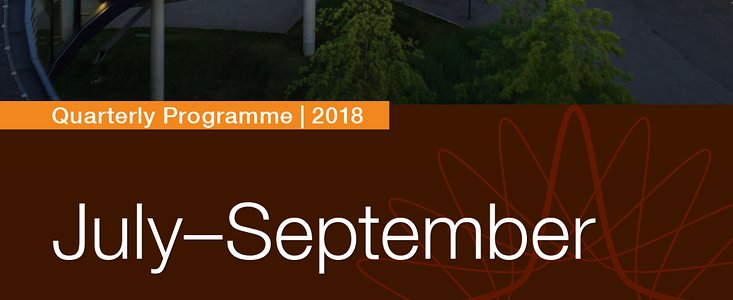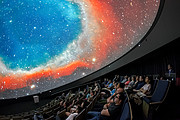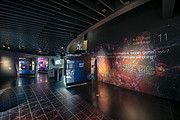Announcement
Captivating new programme at the ESO Supernova
Exciting new range of planetarium shows and events available from July
11 July 2018
Over the past months, the ESO Supernova team has been preparing an amazing new programme of exciting events and shows for our Planetarium & Visitor centre. We are delighted to announce that our July–September programme is now available online and in print. Featuring the latest ESO Supernova activities, the programme contains all you need to know about our forthcoming planetarium shows, guided tours and educational workshops. It also features special public events such as science talks, concerts and much more.
Since its official inauguration on 26 April 2018, the ESO Supernova Planetarium & Visitor Centre has entertained and educated visitors with a range of captivating planetarium shows, guided tours, educational workshops and special events. All these activities are free in 2018 — visitors just need to book in advance. The programme of shows, tours and events at the ESO Supernova changes every three months, giving audiences the chance to experience new aspects of astronomy with each visit. We are delighted to announce that our latest programme, which covers July–September, is now available online.
This programme features new additions to the exciting range of planetarium shows screened in the ESO Supernova’s state-of-the-art digital planetarium. Europe to the stars takes the viewer on an epic journey behind the scenes of the most productive ground-based observatory in the world, revealing the science, history, technology and people of ESO. Also premiering at the ESO Supernova is The Sun, Our Living Star, a new immersive ESO fulldome show directed by talented Greek filmmaker Theofanis Matsopoulos.
An exciting array of special events will also be held at the ESO Supernova, including talks, workshops, concerts and more. In July, audiences will be able to observe the longest total lunar eclipse of the 21st century from the rooftop of the ESO Supernova, and also enjoy a special screening of Back to the Moon for Good. Following their booked-out previous Supernova performance, the musical duo tonelabs will again be performing Fragmented Future. The ESO Supernova will also continue to host the travelling exhibition Our Place In Space, which explores where humanity fits in the grand scheme of our Universe using Hubble-inspired artworks and installations.
The programme also lists all the available tours of the ESO Supernova, in which ESO astronomers and engineers take audiences through some of the biggest questions in astronomy. There will be opportunities for audiences to discover what kind of objects populate our Universe, from planets like the Earth to strange objects like black holes. Some guided tours also give rare insight into the history and future of ESO and allow visitors to explore the intricate architecture of ESO’s buildings.
A printed version of the July–September programme is available, and will soon be distributed to various tourism outlets, hotels, and other partners. It will be available in the ESO Supernova itself and can be downloaded here. To see the full range of activities on offer at the ESO Supernova and to book a place at any of these exciting activities, follow this link, and explore the marvels of the Universe from here on Earth!
More information:
The ESO Supernova Planetarium & Visitor Centre
The ESO Supernova Planetarium & Visitor Centre is a cutting-edge astronomy centre for the public and an educational facility, located at the site of the ESO Headquarters in Garching bei München. The centre hosts the largest tilted planetarium in Germany, Austria and Switzerland and an interactive exhibition, sharing the fascinating world of astronomy and ESO to inspire coming generations to appreciate and understand the Universe around us. All content is provided in English and German and entrance is free, but requires prior booking. For more details visit: supernova.eso.org
The ESO Supernova Planetarium & Visitor Centre is a cooperation between the European Southern Observatory (ESO) and the Heidelberg Institute for Theoretical Studies (HITS). The building is a donation from the Klaus Tschira Stiftung (KTS), a German foundation, and ESO runs the facility.
ESO Supernova is proudly supported by: LOR Foundation, Evans & Sutherland, Sky-Skan and Energie-Wende-Garching.
KTS
The Klaus Tschira Stiftung (KTS) was created in 1995 by the physicist and SAP co-founder Klaus Tschira (1940-2015). It is one of Europe’s largest privately funded non-profit foundations. The Foundation promotes the advancement of the natural sciences, mathematics, and computer science, and strives to raise appreciation for these fields. The Foundation’s commitment begins in kindergarten and continues in schools, universities, and research facilities. The Foundation champions new methods of scientific knowledge transfer, and supports both development and intelligible presentation of research findings.
HITS
The Heidelberg Institute for Theoretical Studies (HITS gGmbH) was established in 2010 by the physicist and SAP co-founder Klaus Tschira (1940-2015) and the Klaus Tschira Foundation as a private, non-profit research institute. HITS conducts basic research in the natural sciences, mathematics and computer science, with a focus on processing, structuring, and analysing large amounts of data. The research fields range from molecular biology to astrophysics. The shareholders of HITS are the HITS Stiftung, which is a subsidiary of the Klaus Tschira Foundation, Heidelberg University and the Karlsruhe Institute of Technology (KIT). HITS also cooperates with other universities and research institutes and with industrial partners. The base funding of HITS is provided by the HITS Stiftung with funds received from the Klaus Tschira Foundation. The primary external funding agencies are the Federal Ministry of Education and Research (BMBF), the German Research Foundation (DFG), and the European Union.
ESO
ESO is the foremost intergovernmental astronomy organisation in Europe and the world’s most productive ground-based astronomical observatory by far. It has 15 Member States: Austria, Belgium, Czechia, Denmark, France, Finland, Germany, Italy, the Netherlands, Poland, Portugal, Spain, Sweden, Switzerland and the United Kingdom, along with the host state of Chile and with Australia as a strategic partner. ESO carries out an ambitious programme focused on the design, construction and operation of powerful ground-based observing facilities, enabling astronomers to make important scientific discoveries. ESO also plays a leading role in promoting and organising cooperation in astronomical research. ESO operates three unique world-class observing sites in Chile: La Silla, Paranal and Chajnantor. At Paranal, ESO operates the Very Large Telescope, the world’s most advanced visible-light astronomical observatory, and two survey telescopes. VISTA works in the infrared and is the world’s largest survey telescope and the VLT Survey Telescope is the largest telescope designed to exclusively survey the skies in visible light. ESO is a major partner in ALMA, the largest astronomical project in existence. And on Cerro Armazones, close to Paranal, ESO is building the 39-metre Extremely Large Telescope, the ELT, which will become “the world’s biggest eye on the sky”.
Links
- Programme for July–September
- The ESO Supernova website
- The ESO Supernova online programme
- ESO Supernova Fact Sheet (PDF)
- Support ESO Supernova
Contacts
Tania Johnston
ESO Supernova Coordinator
Garching bei München, Germany
Tel: +49 89 320 061 30
E-Mail: tjohnsto@eso.org
Oana Sandu
Community Coordinator & Communication Strategy Officer
ePOD
Tel: +49 89 320 069 65
E-Mail: osandu@partner.eso.org
About the Announcement
| Id: | ann18055 |




